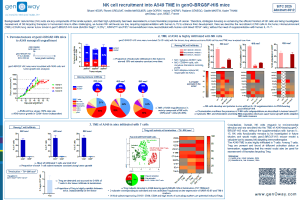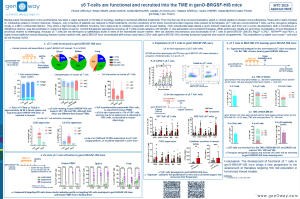Tumor cell line-derived xenograft subtype shapes tumor microenvironment composition in BRGSF-HIS mice
BRGSF-HIS & tumor microenvironment
Abstract
The relevance of preclinical models has vastly improved with mice bearing a human immune system, especially in the context of immunotherapy. BRGSF (Balb/C Rag2−/−, IL2Rγ−/−, SIRPαNOD and Flt3−/−) is a highly immunodeficient mouse featuring reduced murine myeloid cells. BRGSF mice reconstituted with human cord blood CD34+ cells (BRGSF-HIS) develop functional lymphoid and myeloid compartments. This engraftment is stable for over a year (Labarthe et al., 2019) and mice do not develop GvHD. Myeloid compartment can be transiently boosted with exogenous human Flt3L injections. In contrary to other models overexpressing human cytokines to develop human myeloid cells, Flt3L-treated BRGSF-HIS mice do not show side effects. BRGSF-HIS mice are permissive to mouse and human cancer cell lines engraftment and represent a valuable preclinical model to study cancer development and test novel therapeutics. Effect of Flt3L-induced boost on myeloid compartment is seen in a non-small cell lung cancer (A549) tumor model. A single boost prior to tumor cell inoculation associates with increased tumor-infiltrating T-cells (mainly CD8+ T-cells) and myeloid cells, and reduced tumor-infiltrating NK cells in the tumor microenvironment (TME). Human triple negative cancer cell (TNBC) MDA-MB-231 and human pancreatic adenocarcinoma HPAFII cell lines are widely used in cancer research and drug development. We show that upon implantation in BRGSF-HIS mice, in vivo growth of human cell line-derived xenograft (CDX) is CD34+ donor independent and the TME composition varies according to cell line used. As seen in TNBC patients (Zheng et al., 2021); TME of MDA-MB-231 bearing BRGSF-HIS mice is enriched in myeloid cells, mostly CD206+/CD163+ M2 macrophages. CD163-expressing M2 macrophages represent the main tumor-associated macrophages, and are known to promote breast cancer initiation, angiogenesis, invasion, and metastasis by generating an immunosuppressive TME. Interestingly, TME composition evolves over time, with increased T cells frequency in later stage (tumor volume over 1000 mm3 compared to 500 mm3) depicting cancer cell plasticity. Conversely, TME of HPAFII bearing mice is mainly composed of T cells enabling T cells-based therapy. Treatment of BRGSF-HIS mice bearing HPAFII tumor cells with combotherapy based on CD3xTAA + CD28xTAA efficiently reduces tumor growth in vivo compared to vehicle-treated mice or mice injected with CD3xTAA alone. Induced systemic immunomodulation is observed in the TME where increased numbers of both CD4 and CD8 T cells are observed upon combotherapy. Remarkably, while no CD34+ donor effect is observed in CDX growth kinetic, response to treatment appears to be donor dependent with apparition of “weak” and “good” responders. This heterogeneity of response mimics what is observed in clinic and enables further investigations of treatment mode of action and immune escape mechanisms.

Scientific excellence
From model design to experimental results
Featured in 600+ scientific articles

Collaborative approach
Collaboration with 17 Top Pharmas,
170+ Biotechs and 380+ Academic Institutions

Robust validation data on catalog models
Generated with biopharma partners and in-house

Innovative technologies
and guaranteed freedom to operate

Easy access to models
Models with certified health status from professional breeders in US and Europe




.webp)









